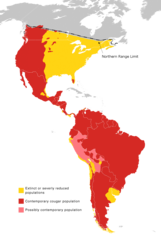Puma
| Puma | |||
| Jardine, 1834[1] | |||
 Przedstawiciel rodzaju – puma płowa (P. concolor) | |||
| Systematyka | |||
| Domena | |||
|---|---|---|---|
| Królestwo | |||
| Typ | |||
| Podtyp | |||
| Gromada | |||
| Podgromada | |||
| Infragromada | |||
| Rząd | |||
| Podrząd | |||
| Infrarząd | |||
| Rodzina | |||
| Podrodzina | |||
| Rodzaj |
puma | ||
| Typ nomenklatoryczny | |||
|
Felis concolor Linnaeus, 1771 | |||
| Synonimy | |||
|
| |||
| Gatunki | |||
| |||
| Zasięg występowania | |||

| |||
Puma[3] (Puma) – rodzaj drapieżnych ssaków z podrodziny kotów (Felinae) w obrębie rodziny kotowatych (Felidae).
Zasięg występowania
[edytuj | edytuj kod]Rodzaj obejmuje jeden żyjący współcześnie gatunek występujący w Ameryce[4][5][6].
Morfologia
[edytuj | edytuj kod]Długość ciała (bez ogona) 86–155 cm, długość ogona 60–97 cm; masa ciała samic 34–48 kg, samców 53–72 kg (wyjątkowo do 120 kg)[5][7].
Systematyka
[edytuj | edytuj kod]Rodzaj zdefiniował w 1834 roku szkocki przyrodnik i ornitolog William Jardine w publikacji swojego autorstwa poświęconej naukom przyrodniczym[1]. Jardine wymienił kilka gatunków – Felis pajeros Desmarest, 1816, Felis concolor Linnaeus, 1771, Felis nigra Jardine, 1834 (= Felis concolor Linnaeus, 1771), Felis eyra G. Fischer, 1814 (= Felis yagouaroundi É. Geoffroy Saint-Hilaire, 1803), Felis chalybeata von Schreber, 1804 (= Felis pardus Linnaeus, 1758) i Felis yaguarundi Lesson, 1827 (= Felis yagouaroundi É. Geoffroy Saint-Hilaire, 1803) – z których gatunkiem typowym jest Felis concolor Linnaeus, 1771.
Etymologia
[edytuj | edytuj kod]- Puma: peruwiańska nazwa (język keczua) Puma dla tego kota[8].
- Viretailurus: Jean Viret (1894–1970), francuski paleontolog; gr. αιλουρος ailouros ‘kot’[2]. Gatunek typowy: †Panthera schaubi Viret, 1954 (= †Felis pardoides R. Owen, 1846).
Podział systematyczny
[edytuj | edytuj kod]Do rodzaju należy jeden występujący współcześnie gatunek[9][7][4][3]:
- Puma concolor (Linnaeus, 1771) – puma płowa
Opisano również gatunki wymarłe[10][11]:
- Puma incurva (Ewer, 1956)[12] (Afryka; plejstocen)
- Puma lacustris (Gazin, 1933)[13] (Ameryka Północna; pliocen)
- Puma pardoides (R. Owen, 1846)[14] (Europa; fanerozoik)
Przypisy
[edytuj | edytuj kod]- ↑ a b W. Jardine: The naturalist’s library. Cz. 16: Natural history of the Felinae. Edynburg: W.H. Lizars, 1834, s. 266. (ang.).
- ↑ a b H. Hemmer. Studien an «Panthera» schaubi Viret aua dem Villafranchien von Saint-Vallier (Drôme). „Neues Jahrbuch für Geologie und Paläontologie. Abhandlungen”. 122 (3), s. 324–336, 1965. (niem.).
- ↑ a b W. Cichocki, A. Ważna, J. Cichocki, E. Rajska-Jurgiel, A. Jasiński & W. Bogdanowicz: Polskie nazewnictwo ssaków świata. Warszawa: Muzeum i Instytut Zoologii PAN, 2015, s. 137. ISBN 978-83-88147-15-9. (pol. • ang.).
- ↑ a b C.J. Burgin, D.E. Wilson, R.A. Mittermeier, A.B. Rylands, T.E. Lacher & W. Sechrest: Illustrated Checklist of the Mammals of the World. Cz. 2: Eulipotyphla to Carnivora. Barcelona: Lynx Edicions, 2020, s. 404. ISBN 978-84-16728-35-0. (ang.).
- ↑ a b M.E. Sunquist & F.C. Sunquist: Family Felidae (Cats). W: D.E. Wilson & R.A. Mittermeier (red. red.): Handbook of the Mammals of the World. Cz. 1: Carnivores. Barcelona: Lynx Edicions, 2009, s. 156–157. ISBN 978-84-96553-49-1. (ang.).
- ↑ D.E. Wilson & D.M. Reeder (red. red.): Genus Puma. [w:] Mammal Species of the World. A Taxonomic and Geographic Reference (Wyd. 3) [on-line]. Johns Hopkins University Press, 2005. [dostęp 2021-05-16]. (ang.).
- ↑ a b Class Mammalia. W: Lynx Nature Books: All the Mammals of the World. Barcelona: Lynx Edicions, 2023, s. 648. ISBN 978-84-16728-66-4. (ang.).
- ↑ T.S. Palmer. Index Generum Mammalium: a List of the Genera and Families of Mammals. „North American Fauna”. 23, s. 598, 1904. (ang.).
- ↑ N. Upham, C. Burgin, J. Widness, M. Becker, C. Parker, S. Liphardt, I. Rochon & D. Huckaby: Treeview of Mammalian Taxonomy Hierarchy. [w:] ASM Mammal Diversity Database (Version 1.11) [on-line]. American Society of Mammalogists. [dostęp 2023-12-14]. (ang.).
- ↑ Puma Jardine 1834 (cougar). Fossliworks. [dostęp 2021-05-15]. (ang.).
- ↑ J.S. Zijlstra, Puma Jardine, 1934, Hesperomys project (Version 23.8.1), DOI: 10.5281/zenodo.7654755 [dostęp 2023-12-14] (ang.).
- ↑ R.F. Ewer. The fossil carnivores of the Transvaal caves: Felinae. „Proceedings of the Zoological Society of London”. 126, s. 83, 1956. DOI: 10.1111/j.1096-3642.1956.tb00426.x. (ang.).
- ↑ Ch.L. Gazin. New felids from the upper Pliocene of Idaho. „Journal of Mammalogy”. 14 (3), s. 251, 1933. DOI: 10.2307/1373825. (ang.).
- ↑ R. Owen: A history of British fossil mammals and birds. London: John Van Voorst, 1846, s. 169. (ang.).
